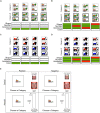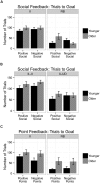Social incentives improve deliberative but not procedural learning in older adults
- PMID: 25932016
- PMCID: PMC4399212
- DOI: 10.3389/fpsyg.2015.00430
Social incentives improve deliberative but not procedural learning in older adults
Abstract
Age-related deficits are seen across tasks where learning depends on asocial feedback processing, however plasticity has been observed in some of the same tasks in social contexts suggesting a novel way to attenuate deficits. Socioemotional selectivity theory suggests this plasticity is due to a deliberative motivational shift toward achieving well-being with age (positivity effect) that reverses when executive processes are limited (negativity effect). The present study examined the interaction of feedback valence (positive, negative) and social salience (emotional face feedback - happy; angry, asocial point feedback - gain; loss) on learning in a deliberative task that challenges executive processes and a procedural task that does not. We predict that angry face feedback will improve learning in a deliberative task when executive function is challenged. We tested two competing hypotheses regarding the interactive effects of deliberative emotional biases on automatic feedback processing: (1) If deliberative emotion regulation and automatic feedback are interactive we expect happy face feedback to improve learning and angry face feedback to impair learning in older adults because cognitive control is available. (2) If deliberative emotion regulation and automatic feedback are not interactive we predict that emotional face feedback will not improve procedural learning regardless of valence. Results demonstrate that older adults show persistent deficits relative to younger adults during procedural category learning suggesting that deliberative emotional biases do not interact with automatic feedback processing. Interestingly, a subgroup of older adults identified as potentially using deliberative strategies tended to learn as well as younger adults with angry relative to happy feedback, matching the pattern observed in the deliberative task. Results suggest that deliberative emotional biases can improve deliberative learning, but have no effect on procedural learning.
Keywords: age; automatic; deliberative; feedback; learning; procedural; social.
Figures



Similar articles
-
Attenuating age-related learning deficits: emotional valenced feedback interacts with task complexity.Emotion. 2013 Apr;13(2):250-61. doi: 10.1037/a0030071. Epub 2012 Nov 19. Emotion. 2013. PMID: 23163707 Free PMC article.
-
Binocular rivalry: a window into emotional processing in aging.Psychol Aging. 2011 Jun;26(2):372-80. doi: 10.1037/a0022029. Psychol Aging. 2011. PMID: 21443353
-
Positivity in Younger and in Older Age: Associations With Future Time Perspective and Socioemotional Functioning.Front Psychol. 2020 Nov 17;11:567133. doi: 10.3389/fpsyg.2020.567133. eCollection 2020. Front Psychol. 2020. PMID: 33281667 Free PMC article.
-
The Role of Emotional Valence for the Processing of Facial and Verbal Stimuli-Positivity or Negativity Bias?Front Psychol. 2019 Jul 26;10:1654. doi: 10.3389/fpsyg.2019.01654. eCollection 2019. Front Psychol. 2019. PMID: 31402884 Free PMC article. Review.
-
Cognitive deficits in bipolar disorders: Implications for emotion.Clin Psychol Rev. 2018 Feb;59:126-136. doi: 10.1016/j.cpr.2017.11.006. Epub 2017 Nov 21. Clin Psychol Rev. 2018. PMID: 29195773 Free PMC article. Review.
Cited by
-
Psychosocial Modulators of Motor Learning in Parkinson's Disease.Front Hum Neurosci. 2016 Feb 29;10:74. doi: 10.3389/fnhum.2016.00074. eCollection 2016. Front Hum Neurosci. 2016. PMID: 26973495 Free PMC article. Review.
-
Reduced dopamine receptors and transporters but not synthesis capacity in normal aging adults: a meta-analysis.Neurobiol Aging. 2017 Sep;57:36-46. doi: 10.1016/j.neurobiolaging.2017.05.006. Epub 2017 May 12. Neurobiol Aging. 2017. PMID: 28599217 Free PMC article.
References
-
- Ashby F. G. (ed.) (2014). Multidimensional models of perception and cognition. Abingdon: Psychology Press.
-
- Ashby F. G., Maddox W. T. (1993). Relations between prototype, exemplar, and decision bound models of categorization. J. Math. Psychol. 37 372–400.
-
- Ashby F. G., Waldron E. M. (1999). On the nature of implicit categorization. Psychon. Bull. Rev. 6 363–378. - PubMed
-
- Blanchard-Fields F., Jahnke H. C., Camp C. (1995). Age differences in problem-solving style: the role of emotional salience. Psychol. Aging 10 173. - PubMed
Grants and funding
LinkOut - more resources
Full Text Sources
Other Literature Sources

